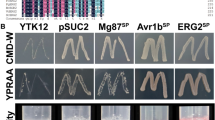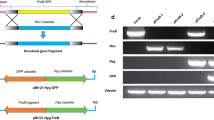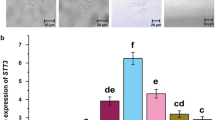Abstract
Verticillium dahliae, a soil-borne fungus, can invade plant vascular tissue and cause Verticillium wilt. The enzyme α-oxoglutarate dehydrogenase (OGDH), catalyzing the oxidation of α-oxoglutarate in the tricarboxylic acid cycle (TCA), is vital for energy metabolism in the fungi. Here, we identified the OGDH gene in V. dahliae (VdOGDH, VDAG_10018) and investigated its function in virulence by generating gene deletion mutants (ΔVdOGDH) and complementary mutants (ΔVdOGDH-C). When the ΔVdOGDH mutants were supplemented with different carbon sources, vegetative growth on Czapek Dox medium was significantly impaired, suggesting that VdOGDH is crucial for vegetative growth and carbon utilization. Conidia of the ΔVdOGDH mutants were atypically rounded or spherical, and hyphae were irregularly branched and lacked typical whorled branches. Mutants ΔVdOGDH-1 and ΔVdOGDH-2 were highly sensitive to H2O2 in the medium plates and had higher intracellular ROS levels. ΔVdOGDH mutants also had elevated expression of oxidative response-related genes, indicating that VdOGDH is involved in response to oxidative stress. In addition, the disruption of VdOGDH caused a significant increase in the expression of energy metabolism-related genes VdICL, VdICDH, VdMDH, and VdPDH and melanin-related genes Vayg1, VdSCD, VdLAC, VT4HR, and VaflM in the ΔVdOGDH mutants; thus, VdOGDH is also important for energy metabolism and melanin accumulation. Cotton plants inoculated with ΔVdOGDH mutants exhibited mild leaf chlorosis and the disease index was lower compared with wild type and ΔVdOGDH-C strains. These results together show that VdOGDH involved in energy metabolism of V. dahliae, is also essential for full virulence by regulating multiple fungal developmental factors.






Similar content being viewed by others
References
Bai YW, Hu DF, Hu XP et al (2011) Formation conditions for microsclerotia of Verticillium dahliae. Mycosystema 30:695–701. https://doi.org/10.13346/j.mycosystema.2011.05.001
Bowyer P, Mueller E, Lucas J (2000) Use of an isocitrate lyase promoter-GFP fusion to monitor carbon metabolism of the plant pathogen Tapesia yallundae during infection of wheat. Mol Plant Pathol 1:253–262. https://doi.org/10.1046/j.1364-3703.2000.00030.x
Bunik VI, Fernie AR (2009) Metabolic control exerted by the 2-oxoglutarate dehydrogenase reaction: a cross-kingdom comparison of the crossroad between energy production and nitrogen assimilation. Biochem J 422:405–421. https://doi.org/10.1042/BJ20090722
Butler MJ, Day AW (1998) Fungal melanins: a review. Can J Microbiol 44:1115–1136. https://doi.org/10.1139/w98-119
Cadenas E, Davies KJA (2000) Mitochondrial free radical generation, oxidative stress, and aging. Free Radic Biol Med 39:222–230. https://doi.org/10.1016/S0891-5849(00)00317-8
Chen JY, Liu C, Gui YJ et al (2018a) Comparative genomics reveals cotton-specific virulence factors in flexible genomic regions in Verticillium dahliae and evidence of horizontal gene transfer from Fusarium. New Phytol 217:756–770. https://doi.org/10.1111/nph.14861
Chen W, Wei L, Zhang Y et al (2018b) Involvement of the two l-lactate dehydrogenase in development and pathogenicity in Fusarium graminearum. Curr Genet 65:591–605. https://doi.org/10.1007/s00294-018-0909-6
Divon HH, Fluhr R (2007) Nutrition acquisition strategies during fungal infection of plants. FEMS Microbiol Lett 266:65–74. https://doi.org/10.1111/j.1574-6968.2006.00504.x
Duressa D, Anchieta A, Chen DQ et al (2013) RNA-seq analyses of gene expression in the microsclerotia of Verticillium dahliae. BMC Genomics 14:2–18. https://doi.org/10.1186/1471-2164-14-607
Fan R, Klosterman SJ, Wang C et al (2017) Vayg1 is required for microsclerotium formation and melanin production in Verticillium dahliae. Fungal Genet Biol 98:1–11. https://doi.org/10.1016/j.fgb.2016.11.003
Foster AJ, Littlejohn GR, Soanes DM et al (2016) Strategies for nutrient acquisition by Magnaporthe oryzae during the infection of rice. In: Unden G, Eckhard T, Anja S (eds) Host-pathogen interaction: microbial metabolism, pathogenicity and antiinfectives. Wiley, Hoboken, pp 93–108
Fradin EF, Thomma BP (2006) Physiology and molecular aspects of Verticillium wilt diseases caused by V. dahliae and V. albo-atrum. Mol Plant Pathol 7:71–86. https://doi.org/10.1111/j.1364-3703.2006.00323.x
Gao F, Zhou BJ, Li GY et al (2010) A glutamic acid-rich protein identified in Verticillium dahliae from an insertional mutagenesis affects microsclerotial formation and pathogenicity. PLoS One 5:e15319. https://doi.org/10.1371/journal.pone.0015319
Gibson GE, Blass JP, Beal MF et al (2005) The α-ketoglutarate-dehydrogenase complex. Mol Neurobiol 31:43–64. https://doi.org/10.1385/mn:31:1-3:043
Han Q, Wu F, Wang X et al (2015) The bacterial lipopeptide iturins induce Verticillium dahliae cell death by affecting fungal signalling pathways and mediate plant defence responses involved in pathogen-associated molecular pattern-triggered immunity. Environ Microbiol 17:1166–1188. https://doi.org/10.1111/1462-2920.12538
Hao YQ, Lu GQ, Wang LH et al (2018) Overexpression of AmDUF1517 enhanced tolerance to salinity, drought, and cold stress in transgenic cotton. J Integr Agric 17:2204–2214. https://doi.org/10.1016/s2095-3119(17)61897-5
Hawke MA, Lazarovits G (1994) Production and manipulation of individual microsclerotia of Verticillium dahliae for use in studies of survival. Phytopathology 23:582–584. https://doi.org/10.1094/Phyto-84-883
Hu D, Wang C, Tao F et al (2014) Whole genome wide expression profiles on germination of Verticillium dahliae microsclerotia. PLoS One 9:e100046. https://doi.org/10.1371/journal.pone.0100046
Jonkers W, Van Kan JAL, Tijm P et al (2011) The FRP1 F-box gene has different functions in sexuality, pathogenicity and metabolism in three fungal pathogens. Mol Plant Pathol 12:548–563. https://doi.org/10.1111/j.1364-3703.2010.00689.x
Khang CH, Park SY, Lee YH et al (2005) A dual selection based, targeted gene replacement tool for Magnaporthe grisea and Fusarium oxysporum. Fungal Genet Biol 42:483–492. https://doi.org/10.1016/j.fgb.2005.03.004
Khosravi C, Benocci T, Battaglia E et al (2015) Sugar catabolism in Aspergillus and other fungi related to the utilization of plant biomass. Adv Appl Microbiol 90:1–28. https://doi.org/10.1016/bs.aambs.2014.09.005
Klimes A, Dobinson KF (2006) A hydrophobin gene, VDH1, is involved in microsclerotial development and spore viability in the plant pathogen Verticillium dahliae. Fungal Genet Biol 43:283–294. https://doi.org/10.1016/j.fgb.2005.12.006
Klimes A, Amyotte SG, Grant S et al (2008) Microsclerotia development in Verticillium dahliae: regulation and differential expression of the hydrophobin gene VDH1. Fungal Genet Biol 45:1525–1532. https://doi.org/10.1016/j.fgb.2008.09.014
Klimes A, Dobinson KF, Thomma BP et al (2015) Genomics spurs rapid advances in our understanding of the biology of vascular wilt pathogens in the genus Verticillium. Annu Rev Phytopathol 53:181–198. https://doi.org/10.1146/annurev-phyto-080614-120224
Klosterman SJ, Atallah ZK, Vallad GE et al (2009) Diversity, pathogenicity, and management of Verticillium species. Annu Rev Phytopathol 47:39–62. https://doi.org/10.1146/annurev-phyto-080508-081748
Klosterman SJ, Subbarao KV, Kang S et al (2011) Comparative genomics yields insights into niche adaptation of plant vascular wilt pathogens. PLoS Pathog 7:e1002137. https://doi.org/10.1371/journal.ppat.1002137
Kotchoni SO, Gachomo EW (2006) The reactive oxygen species network pathways: an essential prerequisite for perception of pathogen attack and the acquired disease resistance in plants. J Biosci 31:389–404. https://doi.org/10.1007/bf02704112
Livak KJ, Schmittgen TD (2001) Analysis of relative gene expression data using real-time quantitative PCR and the 2−ΔΔCT method. Methods 25:402–408. https://doi.org/10.1006/meth.2001.1262
Lorenz MC, Fink GR (2001) The glyoxylate cycle is required for fungal virulence. Nature 412:83–86. https://doi.org/10.1038/35083594
Luo X, Xie C, Dong J et al (2014) Interactions between Verticillium dahliae and its host: vegetative growth, pathogenicity, plant immunity. Appl Microbiol Biot 98:6921–6932. https://doi.org/10.1007/s00253-014-5863-8
Luo X, Mao H, Wei Y et al (2016) The fungal-specific transcription factor Vdpf influences conidia production, melanized microsclerotia formation and pathogenicity in Verticillium dahliae. Mol Plant Pathol 17:1364–1381. https://doi.org/10.1111/mpp.12367
McKinney JD, HzB K, Muñoz-Elías EJ et al (2000) Persistence of Mycobacterium tuberculosis in macrophages and mice requires the glyoxylate shunt enzyme isocitrate lyase. Nature 406:735–738. https://doi.org/10.1038/35021074
Pegg GF, Brady BL (2002) Verticillium Wilts. CABI Pulishing, NewYork
Qi X, Su X, Guo H et al (2016) VdThit, a thiamine transport protein, is required for pathogenicity of the vascular pathogen Verticillium dahliae. Mol Plant Microbe Interact 29:545–559. https://doi.org/10.1094/MPMI-03-16-0057-R
Qi X, Li X, Guo H et al (2018) VdPLP, A patatin-like phospholipase in Verticillium dahliae, is involved in cell wall integrity and required for pathogenicity. Genes 9:e162. https://doi.org/10.3390/genes9030162
Rauyaree P, Ospina-Giraldo MD, Kang S et al (2005) Mutations in VMK1, a mitogen-activated protein kinase gene, affect microsclerotia formation and pathogenicity in Verticillium dahliae. Curr Genet 48:109–116. https://doi.org/10.1007/s00294-005-0586-0
Rehman L, Su X, Guo H et al (2016) Protoplast transformation as a potential platform for exploring gene function in Verticillium dahliae. BMC Biotechnol 16:e57. https://doi.org/10.1186/s12896-016-0287-4
Rehman L, Su X, Li X et al (2017) FreB is involved in the ferric metabolism and multiple pathogenicity-related traits of Verticillium dahliae. Curr Genet 64:645–659. https://doi.org/10.1007/s00294-017-0780-x
Repetto B, Tzagoloff A (1989) Structure and regulation of KGD1, the structural gene for yeast alpha-ketoglutarate dehydrogenase. Mol Cell Biol 9:2695–2705. https://doi.org/10.1128/MCB.9.6.2695
Repetto B, Tzagoloff A (1990) Structure and regulation of KGD2, the structural gene for yeast dihydrolipoyl transsuccinylase. Mol Cell Biol 10:4221–4232. https://doi.org/10.1128/mcb.10.8.4221
Sandeman RA, Hynes MJ, Fincham JR et al (1991) Molecular organisation of the malate synthase gene of Aspergillus nidulans and Neurospora crassa. Mol Genet Genomics 228:445–452. https://doi.org/10.1007/bf00260638
Santhanam P, van Esse HP, Albert I et al (2013) Evidence for functional diversification within a fungal NEP1-like protein family. Mol Plant Microbe Interact 26:278–286. https://doi.org/10.1094/MPMI-09-12-0222-R
Santhanam P, Boshoven JC, Salas O et al (2017) Rhamnose synthase activity is required for pathogenicity of the vascular wilt fungus Verticillium dahliae. Mol Plant Pathol 18:347–362. https://doi.org/10.1111/mpp.12401
Shi Y, Wang H, Yan Y et al (2018) Glycerol-3-phosphate shuttle is involved in development and virulence in the rice blast fungus Pyricularia oryzae. Front Plant Sci 9:e687. https://doi.org/10.3389/fpls.2018.00687
Solomon PS, Tan KC, Oliver RP (2003) The nutrient supply of pathogenic fungi; a fertile field for study. Mol Plant Pathol 4:203–210. https://doi.org/10.1046/j.1364-3703.2003.00161.x
Solomon PS, Lee RC, Wilson TJ et al (2004) Pathogenicity of Stagonospora nodorum requires malate synthase. Mol Microbiol 53:1065–1073. https://doi.org/10.1111/j.1365-2958.2004.04178.x
Su X, Rehman L, Guo H et al (2017) The oligosaccharyl transferase subunit STT3 mediates fungal development and is required for virulence in Verticillium dahliae. Curr Genet 64:235–246. https://doi.org/10.1007/s00294-017-0729-0
Tao L, Zhang Y, Fan S et al (2017) Integration of the tricarboxylic acid (TCA) cycle with cAMP signaling and Sfl2 pathways in the regulation of CO2 sensing and hyphal development in Candida albicans. PLoS Genet 13:e1006949. https://doi.org/10.1371/journal.pgen.1006949
Thines E, Weber RW, Talbot NJ (2000) MAP kinase and protein kinase A-dependent mobilization of triacylglycerol and glycogen during appressorium turgor generation by Magnaporthe grisea. Plant Cell 12:1703–1718. https://doi.org/10.2307/3871184
Tian H, Zhou L, Guo W et al (2015) Small GTPase Rac1 and its interaction partner Cla4 regulate polarized growth and pathogenicity in Verticillium dahliae. Fungal Genet Biol 74:21–31. https://doi.org/10.1016/j.fgb.2014.11.003
Tran VT, Braus-Stromeyer SA, Kusch H et al (2014) Verticillium transcription activator of adhesion Vta2 suppresses microsclerotia formation and is required for systemic infection of plant roots. New Phytol 202:565–581. https://doi.org/10.1111/nph.12671
Tzima A, Paplomatas EJ, Rauyaree P et al (2010) Roles of the catalytic subunit of cAMP-dependent protein kinase A in virulence and development of the soilborne plant pathogen Verticillium dahliae. Fungal Genet Biol 47:406–415. https://doi.org/10.1016/j.fgb.2010.01.007
Vallad GE, Subbarao KV (2008) Colonization of resistant and susceptible lettuce cultivars by a green fluorescent protein-tagged isolate of Verticillium dahliae. Phytopathology 98:871–885. https://doi.org/10.1094/PHYTO-98-8-0871
Voegele RT, Hahn M, Lohaus G et al (2005) Possible roles for mannitol and mannitol dehydrogenase in the biotrophic plant pathogen Uromyces fabae. Plant Physiol 137:190–198. https://doi.org/10.1104/pp.104.051839
Voet D, Voet JG, Pratt CW (2016) Fundamentals of biochemistry: life at the molecular level, fifth, ed edn. John Wiley & Sons Inc., Hoboken
Wang ZY, Thornton CR, Kershaw MJ et al (2003) The glyoxylate cycle is required for temporal regulation of virulence by the plant pathogenic fungus Magnaporthe grisea. Mol Microbiol 47:1601–1612. https://doi.org/10.1046/j.1365-2958.2003.03412.x
Wang C, Lu G, Hao Y et al (2017) ABP9, a maize bZIP transcription factor, enhances tolerance to salt and drought in transgenic cotton. Planta 246:453–469. https://doi.org/10.1007/s00425-017-2704-x
Xie CJ, Wang CY, Wang XK et al (2013) Proteomics-based analysis reveals that Verticillium dahliae toxin induces cell death by modifying the synthesis of host proteins. J Gen Plant Pathol 79:335–345. https://doi.org/10.1007/s10327-013-0467-1
Xiong D, Wang Y, Tang C et al (2015) VdCrz1 is involved in microsclerotia formation and required for full virulence in Verticillium dahliae. Fungal Genet Biol 82:201–212. https://doi.org/10.1016/j.fgb.2015.07.011
Xu M, Gui YJ, Qi WY et al (2013) Verticillium dahliae labeled with green fluorescent protein gene. Plant Protect 39:128–133. https://doi.org/10.3969/j.issn.0529-1542.2013.05.018
Yang YL, Liu ZY, Cai L et al (2009) Colletotrichum anthracnose of Amaryllidaceae. Fungal Divers 39:123–146. https://doi.org/10.1007/s10327-005-0214-3
Yang X, Ding F, Zhang L et al (2015) The importin alpha subunit PsIMPA1 mediates the oxidative stress response and is required for the pathogenicity of Phytophthora sojae. Fungal Genet Biol 82:108–115. https://doi.org/10.1016/j.fgb.2015.04.023
Yun BW, Feechan A, Yin M et al (2011) S-nitrosylation of NADPH oxidase regulates cell death in plant immunity. Nature 478:264–268. https://doi.org/10.1038/nature10427
Zhang WW, Jian GL, Jiang TF et al (2012) Cotton gene expression profiles in resistant Gossypium hirsutum cv. Zhongzhimian KV1 responding to Verticillium dahliae strain V991 infection. Mol Biol Rep 39:9765–9774. https://doi.org/10.1007/s11033-012-1842-2
Zhang L, Ni H, Du X et al (2017) The Verticillium-specific protein VdSCP7 localizes to the plant nucleus and modulates immunity to fungal infections. New Phytol 215:368–381. https://doi.org/10.1111/nph.14537
Zhang DD, Wang J, Wang D et al (2019) Population genomics demystifies the defoliation phenotype in the plant pathogen Verticillium dahliae. New Phytol. https://doi.org/10.1111/nph.15672
Zhao YL, Zhou TT, Guo HS (2016) Hyphopodium-specific VdNoxB/VdPls1-dependent ROS-Ca2+ signaling is required for plant infection by Verticillium dahliae. PLoS Pathog 12:e1005793. https://doi.org/10.1371/journal.ppat.1005793
Zhao Y-L, Zhang T, Guo H-S (2017) Penetration assays, fungal recovery and pathogenicity assays for Verticillium dahliae. Bio-Protocol 7:1–8. https://doi.org/10.21769/BioProtoc.2133
Zhou BJ, Jia PS, Gao F et al (2012) Molecular characterization and functional analysis of a necrosis- and ethylene-inducing, protein-encoding gene family from Verticillium dahliae. Mol Plant Microbe Interact 25:964–975. https://doi.org/10.1094/MPMI-12-11-0319
Zhu H-Q, Feng Z-L, Li Z-F et al (2013) Characterization of two fungal isolates from cotton and evaluation of their potential for biocontrol of Verticillium wilt of cotton. J Phytopathol 161:70–77. https://doi.org/10.1111/jph.12027
Acknowledgements
This research was supported by a grant from the National Natural Science Foundation of China (31701861 and 31772244), the special fund for agro-scientific research in the public interest (201503109), and the Agricultural Science and Technology Innovation Program of CAAS, and the Fundamental Research Funds for Central Non-profit Scientific Institution (Y2017JC57).
Author information
Authors and Affiliations
Corresponding authors
Ethics declarations
Conflict of interest
The authors declare that they have no conflict of interest.
Ethical approval
This article does not contain any studies with human participants performed by any of the authors.
Additional information
Communicated by M. Kupiec.
Publisher's Note
Springer Nature remains neutral with regard to jurisdictional claims in published maps and institutional affiliations.
Electronic supplementary material
Below is the link to the electronic supplementary material.
Rights and permissions
About this article
Cite this article
Li, X., Su, X., Lu, G. et al. VdOGDH is involved in energy metabolism and required for virulence of Verticillium dahliae. Curr Genet 66, 345–359 (2020). https://doi.org/10.1007/s00294-019-01025-2
Received:
Revised:
Accepted:
Published:
Issue Date:
DOI: https://doi.org/10.1007/s00294-019-01025-2




